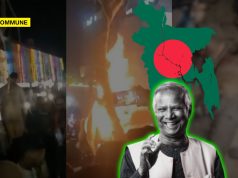
On Tuesday, 21 February, outgoing Seattle City Council member Kshama Sawant, a member of the Trotskyist Socialist Alternative political party, succeeded in passing a bill adding the category of ‘caste’ to the city’s non-discrimination statute. Many supported it and many opposed it. Those who oppose it do so, not because they disagree on whether caste discrimination should be addressed, rather their point of contention was about how it should be addressed. Thus, first time in the history of the United States a city passed in effect a ‘discriminatory’ legislation targeting a specific community based on their ethnicity or national origin and on basis of prejudiced dogma that they have such a unique form of bigotry that a special policy shall be bought in just to monitor them. The bill does not even consider the repercussions it can have on the harmony of Hindu communities in Western nations. In this context this article will understand why anti-caste legislation by a city in the USA represents the rising trend of Hindu phobia in the West?
“For the First time in the history of the United States a city passed in effect a ‘discriminatory’ legislation targeting a specific community based on their ethnicity or national origin and on basis of prejudiced dogma that they have such unique form of bigotry that a special policy shall be brought in just to monitor them. The bill does not even consider the repercussions it can have on the harmony of Hindu community in Western nations.”
As soon as these incidents unravelled, Hindu American Foundation (HAF) co-founder and Executive Director Suhag Shukla said in an official statement, “Throughout our two decades of existence, HAF has maintained that caste discrimination is wrong, violating core Hindu principles of the divine oneness of all beings. At the same time, we maintain that the singling out of South Asians and the addition of ‘caste’ to the non-discrimination policy violates the policies it now amends. The City of Seattle has voted to treat South Asians so that no other ethnic or racial community is treated under the guise of non-discrimination. It has voted yes to discriminating against ethnic minorities, repeating the ugliness of nativists in the state nearly a century ago.” To put it into perspective, it is the US we are talking about. A progressive nation that is open to freedom of speech and expression, but the parameters in the bill makes it blatantly violative of US constitutional guarantees.
HAF Managing Director Samir Kalra said, “Seattle has taken a dangerous misstep here, institutionalising bias against all residents of Indian and South Asian origin, all in the name of preventing bias. When Seattle should be protecting the civil rights of all its residents, it is actually violating them by running roughshod over the most basic and fundamental rights in US law, all people being treated equally.” HAF further noted that Councilmember Sawant claimed caste discrimination is “rampant” in the US. However, only the Carnegie Endowment has done the only authoritative survey on discrimination against the Indian and South Asian communities in the country that noted that caste-based discrimination is rare in the US. The survey specifically debunked the methodology and findings of the dubious organisation Equality Labs, which was the base of Sawant’s resolution. First Hindu and Indian State Senator of Ohio, Niraj Antani, criticised the ordinance passed by Seattle. He said, “I condemn in the strongest terms the ordinance passed by the Seattle City Council. Caste discrimination simply doesn’t exist now. Adding it to their non-discrimination policy is Hindu phobic and is a tool for those who are anti-Hindu use to discriminate against Hindus in America, India, and around the world. Instead of passing this racist policy, Seattle should be passing policies to protect Hindus from discrimination.” The mainstream media is mostly silent on the issue. HAF added that by passing the resolution, Seattle had violated the equal protection and due process guaranteed to every person by the United States Constitution. Notably, as per the constitution, the state is prohibited from treating people disparately on the basis of their national origin, religion or ethnicity. The Foundation’s attorneys contended that the resolution would implement a vague, facially discriminatory and arbitrary category against the Hindus.
Sawant has described the bill as “historic.” That’s true. But for different reasons than she’s touting. Sawant’s wordings of the bill specifically defines caste discrimination as something found in the “South Asian region” and then goes on to falsely tie caste to Hinduism, by writing that “its existence is linked to the religiously sanctioned social structure of Hinduism.” The bill also added immigrants and diasporic communities from Japan, certain African countries and the Middle East. These wordings made the situation even worse by targeting Hindu diaspora abroad. The bill is a true representation of Western misunderstanding of Hindu culture and civilization and it is an act of targeting Hindu’s rather than addressing the violence committed against the community. But politicians and mainstream media are silent on the issue. Whatever their agenda may be, the facts on the ground are crystal clear for anyone to inspect. The ground report from the west reflects the true picture of rising extremism in the west against the Hindus. Let me paint a clearer picture from recent examples.
Hindu phobia or anti-Hindu hatred have a tragically long history which continues to this day across the globe. They are fuelled by a range of factors, including religious intolerance, religious exclusivism, a lack of religious literacy, misrepresentation in the media, academic bias still rooted in oftentimes racist, colonial-era mis portrayals and, in the diaspora, generalised anti-immigrant xenophobia and hatred. This has been professed by colonisers of the Indian subcontinent in form of control over temple wealth and enactment of acts such as Lex Loci Act, 1850 which was one of the root causes for 1857 first war of Indian Independence. Presently, this is being done in Islamic countries and western nations which are being ignored by mainstream media. In Pakistan for example, 1,000 girls between the ages of 12-25 from minorities are forcibly converted to Islam every year and married to their abductors, which described the situation as a “human-rights catastrophe” and in Bangladesh, these incidents are being considered as a part of daily life for Hindus. For example, a mob of 200 perpetrators desecrated ISKCON Radhakanta Temple in Bangladesh’s Dhaka which was part of incidents targeting Hindu’s in Bangladesh and surprisingly this incident happened on March 17th which came right after the United Nations (UN) declared March 15th as International Day to combat Islamophobia.
India had risen to this occasion and rightly questioned the existing bias during the passage of the UN resolution. During the passage, India along with France gave an explanation of ‘Vote of concern’ stating that combatting the hatred against one specific religion was being elevated to an international day for the first time. In fact, this also marked the instance where in atrocities against other religions, specifically, non-Abrahamic religions are being ignored. The political ambivalence to concerns of Hindu community is also an issue in the West. Recent attacks and the lack of credible condemnation against vandalization of 3 Hindu temples in Australia, Vandalization of temples in Canada and general violence against Hindu’s in the Subcontinent speaks volumes on this issue. The US, leader of human rights enforcing its ambit via military measures across the world had never recognized slaughter of Hindu Bangladeshis during 1971 war but US administration was happy to recognise Armenian genocide by Turkey which fits their propaganda of being human rights champions perfectly.
Now, let us come back to what is happening in the US. Attacks against the Hindu community in the USA has become a persistent theme now. In a briefing hosted by the Coalition of Hindus of North America, Joel Finkelstein, the project’s lead researcher, pointed to memes and online social cyber signals referring to perceived “dirty” and “scamming” qualities of Hindus, as well as depictions of Hindus being brutalised. Many of the memes, he said, were manufactured out of commonly used tropes against Jewish people, using tilaks, swastikas and bindis to signify Hindu culture. Because the verbiage and tropes surrounding Hindu phobia are not yet recognized by social media platforms like Twitter, this kind of targeted hatred, which “reliably precedes real-world violence,” largely goes unchecked, Finkelstein said. Because the verbiage and tropes surrounding Hindu phobia are not yet recognized by social media platforms like Twitter, this kind of targeted hatred, which “reliably precedes real-world violence,” largely goes unchecked, Finkelstein said. “Unfortunately, these incidents are evidence of the unhindered Hindu phobia that refuses to be given mainstream acknowledgement,” said Pushpita Prasad, of the Coalition of Hindus of North America. She said COHNA (Coalition of Hindus of North America) often battles with academics, activists and “blue-check” journalists to acknowledge the existence of anti-Hindu hate.
The violence against Hindus and scathing attacks in the form of discriminatory legislation in western nations are resulting in a wave of anti-Hindu climate in Western nations. It is high time that these progressive regions acknowledge rampant anti-Hindu hate and take measures against it without discriminating against the victim itself.
(This article was originally published in The Pulse and has been republished here with permission.)
Click here to subscribe to The Commune on Telegram and get the best stories of the day delivered to you personally.




